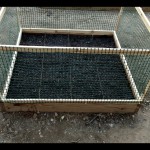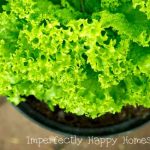The best DIY soil mix recipe has been a long time in the making. This DIY soil mix isn’t just something I threw together on a whim and hoped it worked; I spent a lot of tireless hours researching this! I love this soil as a DIY potting soil and for my Square Foot Garden Boxes.
I’ve been using a combination of Mel’s Mix and potting soil on our little homesteading; and the results haven’t been horrible. But I wanted to take our garden to the next level. I wanted a DIY soil mix that would hold moisture, be full of rich nutrition, be lighter (less compaction) and more sustainable. The result is the best DIY soil mix recipe around!
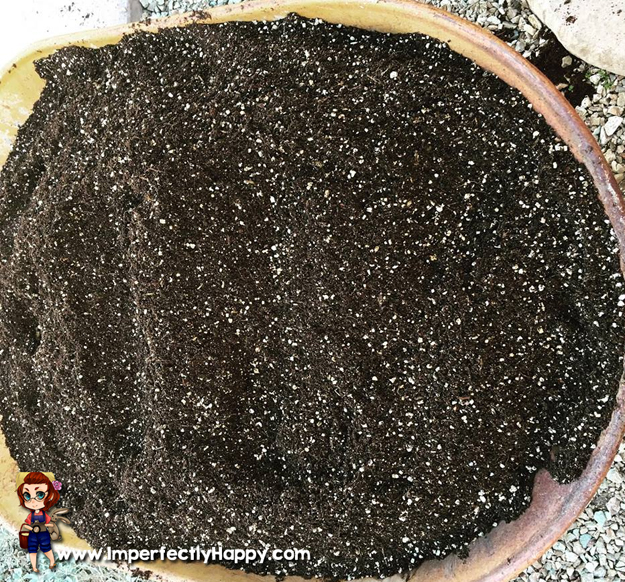
The Best DIY Soil Mix Recipe
DIY Potting Soil and Raised Bed Recipe
I mixed mine up in a wheel barrow this time but this makes mixing a lot harder. It would be better to do this on a thick tarp.
10 gallons of coconut coir (What I used)
5 gallons of sifted compost (Hopefully you’re composting at home)
2 gallons of worm castings (what I used)
8 quarts of organic vermiculite (what I used)
5 cups of Azomite (what I used)
I like to mix in each ingredient at a time.
- So first I put down the coconut coir, then I added my sifted compost and used my hands to incorporate them together.
- I repeated that with the worm castings and vermiculite.
- Lastly I added the azomite (be careful not to breathe the dust in!)
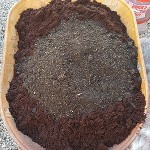
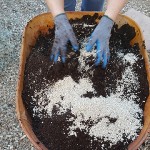
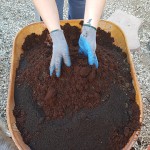
Now it is ready for use or you can store it in a bin or bags. I like to keep a top on it so it won’t get too dried out.
Check out this side by side comparison. On the left is a popular store-bought raised bed soil and on the right is my mix.
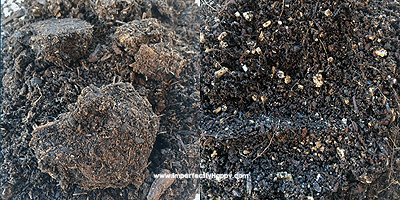
Now, let’s talk about the ingredients and why I included them
Ingredient 1 – Coconut Coir
Coconut coir is, first, a wonderful peat moss substitute. Peat moss is not sustainable; we are mining and using it at such a high rate coconut coir that it cannot renew before we run out. Coconut coir is leftover from the coconut industry, that was thrown away. What coconut coir does is add a spongy quality that it going to help your soil retain moisture (it can hold 10x its weight in water). It doesn’t clump and will not degrade in your soil as quickly as peat moss either. It will as a dried brick and you’ll need to soak this in some water to re-hydrate it. If you have coconut coir left over, don’t throw it away! Just store it for the next time you make your DIY soil mix. I soak mine in a tub and break it up a little as I go.
![]() Ingredient 2 – Worm Castings
Ingredient 2 – Worm Castings
Worm castings are an amazing natural fertilizer. What’s great, too, is that plants soak up its nutrients quickly so it can stimulate growth better than any manure or chemical fertilizer. It can even help a plant fight off diseases by drawing out toxins. Worm castings also improve the texture of the soil, help to increase drought resistance AND it promotes good microbial activity. The best way to get this amazing additive is to be vermicomposting with your own little worms. But it isn’t a project I have going right now, so I opted to buy mine.
Ingredient 3 – Sifted Compost
I love compost – it is basically free soil, when you do it yourself. This fertile soil builder is a must have for homestead gardens. I like to sift mine because I don’t need “uncooked” materials continuing to break down and heat up the soil (120 degrees isn’t unheard of in Phoenix).
If you need some help getting started with compost check out Compost 101. If you decide to buy it, just make sure you’re getting it from a reputable supplier that is using organic materials without pesticides or other junk.
![]() Ingredient 4 – Organic Vermiculite
Ingredient 4 – Organic Vermiculite
Vermiculite helps keep soil from compacting but it also great for water retention. I live in a desert climate so I want to have ingredients that help my soil retain water. If you’re in a climate that gets a lot of rain you might want to consider perlite instead. Both are great additives but vermiculite is more sponge-like. So depending on your climate, choose what suits your needs.
Ingredient 5 – Azomite
Azomite (pronounced ā-zō-mite) stands for A to Z Of Minerals Including Trace Elements. Azomite is going to give your soil a power punch of minerals. What’s great about Azomite is that it is a slow release. So while your compost and worm castings are giving the initial dose of good nutrients, Azomite is going to follow them. Also Azomite won’t burn you plants…even if you put a ton of it in there.
What’s even cooler is that Azomite has been shown to help gardeners to produce more fruits and vegetables (and bigger) per plant. And the minerals improve the nutrition for US! Winner, winner, chicken dinner!
If you want to read more about Azomite check out Azomite.com
I hope my mix will help take your garden to the next level – I am using this in both my pots and raised bed. It could also be a great amendment to already established beds.
Happy gardening my friends!
More Soil Helpers
HOW TO USE RABBIT POOP FERTILIZER FOR A BETTER GARDEN
HOW TO IMPROVE SOIL WITHOUT A COMPOST PILE
AWESOME SOIL AMENDMENTS FOR YOUR ORGANIC VEGETABLE GARDEN
HOW TO USE ORANGE PEELS FOR A BETTER GARDEN

